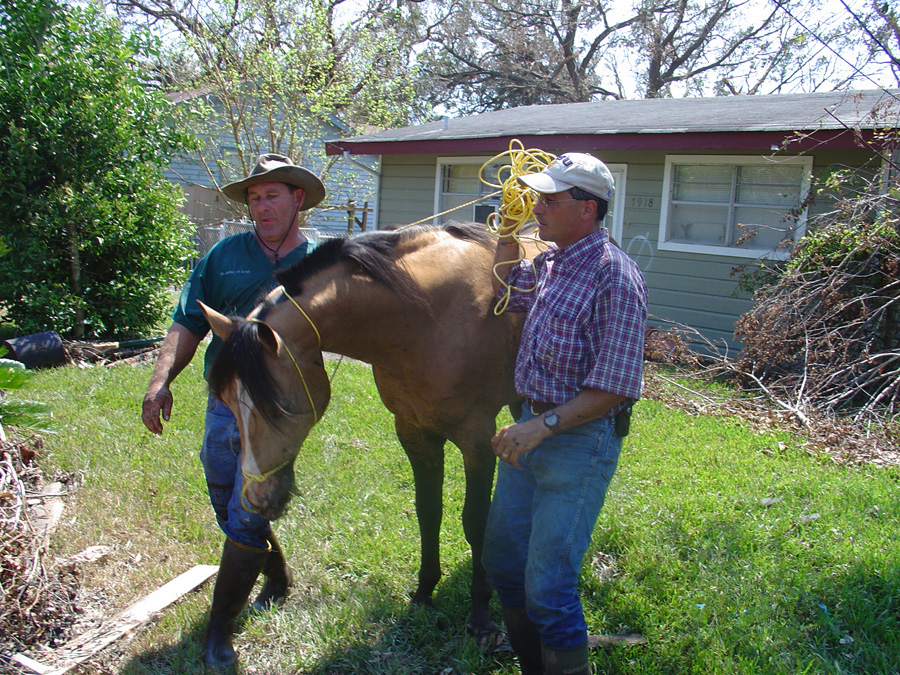Katrina at 20
20 heroic tales of people helping animals
as told to Sandra Sarr, LSU Vet Med strategic communications
Rebecca S. McConnico, DVM (LSU 1987), PhD, DACVIM (with Dennis D. French, DVM; Bonnie Clark; Ky E. Mortensen, BS; Martha Littlefield, MS, DVM (LSU 1982); and Rustin M. Moore, DVM, PhD, DACVS

From left, Dr. Jay Artell (LSU 1994) and Dr. Shannon Gonsoulin (LSU 1994) rescuing a horse.
An excerpt, Equine Rescue and Response Activities in Louisiana in the Aftermath of Hurricanes Katrina and Rita, published in American Veterinary Medicine Association, August 2007.
“Evacuation was the safest choice for most horses. However, this was costly, required that a vehicle and adequate fuel be available, and required that the owner be knowledgeable about appropriate facilities where evacuated horses could be stabled. In addition, traffic became an important issue, and some horse and livestock owners were prevented from evacuating their animals once New Orleans began mandatory evacuation of its residents. As an example, a carriage horse company located in downtown New Orleans encountered major traffic tie-ups while attempting to evacuate its last load of mules and horses. With little progress being made and time growing short before anticipated landfall of the storm, the owners had to turn back and seek shelter at their home stable near the historic French Quarter in New Orleans. On Sept. 4, 21 carriage mules and horses were finally evacuated from New Orleans.
Many of the animals that survived the storm and subsequent flooding were stranded on high ground or left standing in water and mud. Initially, New Orleans sustained only wind damage and flooding caused by the storm surge. However, when the levees broke on the following day, flooding occurred in over 80 percent of Orleans Parish. Many horses that had survived the storm surge from Lake Pontchartrain and inland waters would later drown, trapped by the rising water caused by the levee breaks. The initial Katrina equine response plan included staffing this response shelter, the Lamar Dixon Expo Center, with veterinarians and veterinary students from LSU Vet Med under the direction of a shelter manager designated by the state veterinarian's office. A list of trailer owners and drivers and on-call equine veterinarians who would volunteer their services for two-week shifts was developed to assist with equine response activities. Approximately 32 volunteer LSU Equine Health Studies Program faculty members, residents, interns, veterinary students, undergraduate students, clinic and research technicians, family members of LSU Vet Med employees, and lay volunteers, answered telephone calls during the four weeks of operation. The information obtained through these telephone calls, combined with information obtained by Equine Branch response teams from on-the-ground military operations concerning horses and other animals encountered during human search-and-rescue operations, was used to plan each day's equine rescue missions. Additional information was gathered each day from the response teams' reconnaissance efforts. The Equine Branch's communications center activities expanded as the challenges grew in the aftermath of the storms, with rescue activities for Katrina-affected horses continuing through the third week of September. Daily planning for ongoing Equine Branch field operations was typically completed between 9 p.m. and 12 a.m. because response teams usually returned late at night. Equine response teams hauled needed supplies to care providers and owners who were continuing to shelter in-place and, after unloading, would retrieve horses, other livestock, and pets that needed to be evacuated. Shelter volunteers slept in stalls, tents, and vehicles on site because they took on the responsibility of providing security for the Equine Response Shelter and other accommodations were not available. Because of its close proximity to the Lamar Dixon (23 miles), the LSU Veterinary Teaching Hospital served as a resource and referral facility for horses with more serious injuries. Approximately 15 horses were admitted to the LSU as a direct result of injuries or illnesses sustained during and after the storms. In addition, several horses with preexisting conditions that required treatment, such as chronic laminitis and other stress-related conditions, were admitted to the LSU hospital.
Approximately 500 horses were eventually rescued and cared for by the EHSP and LSART teams during the aftermath of Hurricanes Katrina and Rita. Additionally, the equine response teams assisted with the evacuation of more than 300 dogs and other animals, including cats, birds, iguanas, goats, and potbellied pigs, and even assisted in the rescue of some people. At the Katrina Equine Response Shelter, approximately 390 animals were handled by equine response teams, including 370 equids, 15 goats, and 3 pigs. The highest number of horses received on any single day was the 79 horses received on Sept. 9. The mean number of horses cared for per day during this period was 157. Eighty horses were rescued and cared for by LSART equine response team members and care providers in central Louisiana following Hurricane Rita. Approximately 500 volunteers dedicated time with the Louisiana equine response team.”